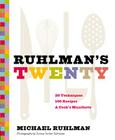It’s unfortunate that we’ve learned to view recipes as something to be followed rather slavishly. That’s not the way cooking works since there are so many variables in ingredients available. If we can get out of that habit, then we’ve made a huge stride in cooking for one.
I’ve talked about Pam Andersen’s How to Cook without a Book-–which is based on using ratios in recipes. Even more liberating from the slavish following of recipes are a number of books which really don’t give specific quantities at all or just suggest approximations of ingredients. These can be easily adjusted if you pay attention to the proportions of the main ingredients or the ratios.
 I just purchased Michael Ruhlman‘s Twenty. I found it a fascinating approach to cooking–it introduces you to the really important ingredients that you work with so often that you almost do not think about them–you take them for granted: like salt, eggs, water (yes, water!) and onions, to mention a few. He presents recipes that will make you aware of how these ingredients actually work in the process of cooking–to help you understand them so that you can improvise!
I just purchased Michael Ruhlman‘s Twenty. I found it a fascinating approach to cooking–it introduces you to the really important ingredients that you work with so often that you almost do not think about them–you take them for granted: like salt, eggs, water (yes, water!) and onions, to mention a few. He presents recipes that will make you aware of how these ingredients actually work in the process of cooking–to help you understand them so that you can improvise!
Another great thing about this book is that even though the recipes may be for more servings than you want, ratios are given for important ingredients. For example, in a recipe for “Traditional French Onion Soup”, he give a and “onion-to-liquid” ratio that he prefers for the main ingredients–7 or 8 pounds onions (which really cook down) to 6 cups of water. That gives you the information you need to downsize the recipe. Other ingredients are mostly “to taste” although quantities are suggested in the base recipe. It’s wonderful when the recipes give you this kind of information; however, you can always look at the major ingredients in a recipe and come up with your own ratio.
This book stresses “thinking about food”–and that does not mean looking at the recipe that has 20 ingredients, and dreaming about how nice it would be to make that, but it serves 16, and…. Techniques that are basic to many recipes are presented–some of them are basic ingredients–to help you understand the why and the wherefore of the ingredients. That is the key to improvising. The other important thing stressed: think! Once you understand ingredients, you can adjust the recipe, you can improvise.
This is a book that I’d recommend highly–at least check it out of the library and read it–it just might give some food for though, and open some doors to make single-serving cooking easier for you. I’d also suggest checking out Michael Ruhlman’s website for other good information for the home cook.

Pingback: There’s an app for improvisation | A single serving
I own 20 as well. Very interesting cookbook. I used to teach cooking lessons, and I found the women always had to follow recipes to a T, whereas the men were more of the “throw in this and that” camp. I have no idea why. Often on my blog I have “guides” more than recipes, where I just list the ingredients. Sometimes ratios are critical, but often they’re not – like fresh salsa. You really love cilantro? Add more! But anyway, I love this post!
LikeLike
As you can probably tell, I like his books. I did some meal planning/cooking consulting and I found the same male/female difference for the most part. I don’t have any idea why either.
I have scads of cookbooks, but use specific recipes seldom–I read them for ideas, cultural information, then go play with the concept! I really don’t by a book if it’s just one recipe after another. I think I’d hate cooking if I had to slavishly follow a recipe for everything.
LikeLike
I completely agree with you!
LikeLike
20 is indeed an excellent book. But his ratio “bible” has to be the aptly titled RATIO. A must for all cooks. The other key idea here is measuring by weight. This is gradually gaining traction in North America though the progress (measured by cookbooks and blogs still showing imperial volume measures) is slow.
An other benefit of ratios is to be able to calculate a recipe where the given is a specific weight of one of the ingredients.
LikeLike
I certainly would not want to give up my scales! I agree it’s so much easier to do the calculations by weight–I’d prefer metric too.
LikeLike